Prince Arthur of Connaught
| Prince Arthur | |
|---|---|
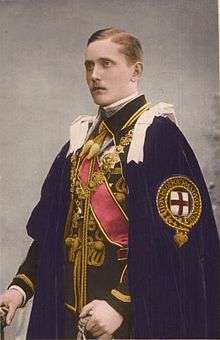 Prince Arthur in the robes of the Order of the Garter | |
| Governor-General of South Africa | |
| Predecessor | The Viscount Buxton |
| Successor | The Earl of Athlone |
| Born |
13 January 1883 Windsor Castle, Berkshire |
| Died |
12 September 1938 (aged 55) London |
| Burial |
22 September 1938 St George's Chapel, Windsor Castle and later Royal Burial Ground, Frogmore |
| Spouse | Princess Alexandra, 2nd Duchess of Fife |
| Issue | Alastair, 2nd Duke of Connaught and Strathearn |
| Father | Prince Arthur, Duke of Connaught and Strathearn |
| Mother | Princess Louise Margaret of Prussia |
| Occupation | Governor-General of South Africa, military officer |
| House |
Windsor (since 1917) Saxe-Coburg and Gotha (until 1917) |
Prince Arthur of Connaught KG KT GCMG GCVO GCStJ CB PC (Arthur Frederick Patrick Albert; 13 January 1883 – 12 September 1938) was a British military officer and a grandson of Queen Victoria. He served as Governor-General of the Union of South Africa from 20 November 1920 to 21 January 1924.
Early life
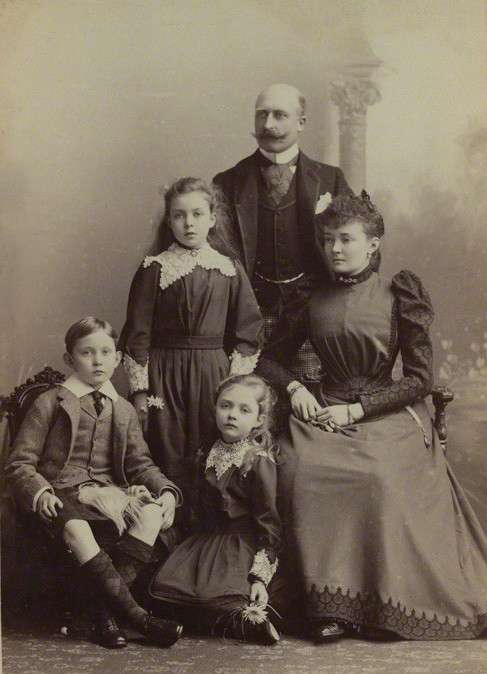
Prince Arthur was born on 13 January 1883 at Windsor Castle. His father was the Duke of Connaught and Strathearn, third son of Queen Victoria and Prince Albert of Saxe-Coburg and Gotha. His mother was the former Princess Louise Margaret of Prussia.
Arthur was baptised in the Private Chapel of Windsor Castle on 16 February 1883, and his godparents were Queen Victoria (his paternal grandmother), Princess Augusta of Saxe-Weimar-Eisenach (his great-great aunt, for whom his paternal aunt The Princess Beatrice stood proxy), Prince Friedrich Leopold of Prussia (his maternal uncle, who was represented by the German Ambassador Count Münster), Princess Henry of the Netherlands (his maternal aunt, who was represented by Countess Münster), the Duke of Cambridge (the Queen's cousin), and the Duke of Edinburgh (his paternal uncle, whose brother the Prince of Wales represented him).[1]
Arthur was the first British royal prince to be educated at Eton College.
Military career
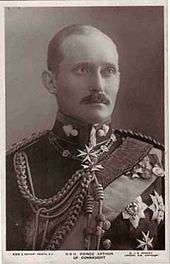
After attending finishing school, Prince Arthur was educated at the Royal Military College, Sandhurst, from where he was commissioned into the 7th (Queen's Own) Hussars in 1901. During the Second Boer War, he saw active duty with the 7th Hussars and spent several months stationed at Krugersdorp. In 1907, he was promoted to the rank of captain in the 2nd Dragoons (Royal Scots Greys). He became the honorary Colonel-in-Chief of this regiment in 1920.
During the First World War, Prince Arthur served as aide-de-camp to Generals Sir John French and Sir Douglas Haig, the successive commanders of the British Expeditionary Force in France and Belgium. He was promoted to lieutenant colonel in 1919 and became a colonel in the reserves in 1922. In October 1922, Prince Arthur was promoted to the honorary rank of major general and became an aide-de-camp to his first cousin, King George V.
Since the king's children were too young to undertake public duties until after the First World War, Prince Arthur carried out a variety of ceremonial duties at home and overseas.
Marriage
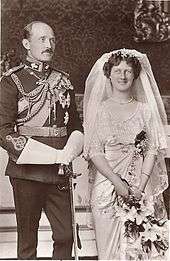
On 15 October 1913, Prince Arthur married Princess Alexandra, 2nd Duchess of Fife (17 May 1891 – 26 February 1959) at the Chapel Royal, St. James's Palace, London.[2]
The couple were attended by five bridesmaids: The Princess Mary, Princess Maud of Fife, Princesses Mary, Helena, and May of Teck. [3]
Princess Alexandra was the eldest daughter of the late Duke of Fife and The Princess Royal, the eldest daughter of King Edward VII. As such, the couple were first cousins once removed. Princess Alexandra held the title of Duchess of Fife in her own right.
After their marriage, Arthur and Alexandra were styled Their Royal Highnesses Prince and Princess Arthur of Connaught.
Together they had one child:
- Alastair (formerly Prince Alastair of Connaught) (9 August 1914 – 26 April 1943). Alastair was styled from 1917 by the courtesy title of Earl of Macduff until he succeeded at his grandfather's death as 2nd Duke of Connaught and Strathearn.
Later life
After the accession of his cousin, King George V, Prince Arthur and his aging father were the most senior male members of the Royal Family over the age of 18 to reside in the United Kingdom. As such, he undertook a wide variety of royal duties on behalf of the King, and acted as a Counsellor of State during periods of the King's absence abroad.
In 1906, by order of the King, he vested the Meiji Emperor of Japan with the Order of the Garter, as a consequence of the Anglo-Japanese Alliance. In 1918, he was a guest aboard the Japanese battlecruiser Kirishima when she voyaged from Japan to Canada.[4] In 1920, Prince Arthur succeeded Viscount Buxton as governor-general and commander-in-chief in South Africa. The Earl of Athlone succeeded him in these posts in 1924. Upon returning to Britain, Prince Arthur became involved in a number of charitable organizations, including serving as chairman of the board of directors of Middlesex Hospital. Like his father, the Duke of Connaught, he was active in the Freemasons, becoming Provincial Grand Master for Berkshire in 1924.
Prince Arthur of Connaught died of stomach cancer at age 55 on 12 September 1938. He is buried in the Royal Burial Ground, Frogmore. One of his last public appearances was at the coronation of King George VI and Queen Elizabeth in May 1937. His father, the Duke of Connaught, survived him by four years. Prince Arthur's only son, who used the courtesy title Earl of MacDuff after 1917, succeeded his paternal grandfather as 2nd Duke of Connaught and Strathearn and Earl of Sussex in 1942.
Titles, styles, honours and arms
Titles and styles
- 13 January 1883 – 12 September 1938: His Royal Highness Prince Arthur of Connaught
A grandson of Queen Victoria, he was a British prince with the style His Royal Highness.
Honours
- KG: Royal Knight of the Garter (15 July 1902)[5]
- KT: Knight of the Thistle[6] (14 October 1913)
- PC: Privy Counsellor (11 June 1910)[7]
- CB: Companion in the Order of the Bath[6] (18 February 1915)
- Royal Victorian Chain (15 May 1906) - for travelling to Japan and investing Emperor Meiji with the Order of the Garter
- GCMG: Knight Grand Cross of the Most Distinguished Order of St Michael and St George (3 September 1918)[8]
- GCVO: Knight Grand Cross of the Royal Victorian Order (24 May 1899)[9]
- GCStJ: Bailiff Grand Cross of St John (12 June 1926)[10]
- KJStJ: Knight of Justice of St John (25 July 1905)[11]
- Knight Grand Cross with Collar of St Olav
- Grand Cordons of the Order of the Chrysanthemum (20 February 1906) [12]
- Personal Aide-de-Camp to The King[6]
Medals
- 1914 Star (1917)
- British War Medal (1919)
- Victory Medal (1919)
- Queen Victoria Diamond Jubilee Medal (1897)
- King Edward VII Coronation Medal (1902)
- King George V Coronation Medal (1910)
- King George V Silver Jubilee Medal (1935)
- King George VI Coronation Medal (1937)
Military record
- 2Lt: 2nd Lieutenant, 7th (Queen's Own) Hussars (8 May 1901)
- Lt: Lieutenant, 7th (Queen's Own) Hussars (14 January 1903)
- Capt: Captain, 2nd Dragoons (The Royal Scots Greys) (27 April 1907)
- Bvt Maj: Brevet Major (14 October 1913)
- Maj: Major, 2nd Dragoons (The Royal Scots Greys) (19 August 1915)
- Bvt LtCol: Brevet Lieutenant-Colonel (3 June 1919)[13]
- Retired from active service (31 December 1919)[14]
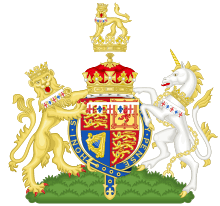
- Hon Maj-Gen: Honorary Major-General (27 October 1920)[15]
- Col: Colonel, Reserve of Officers (1 March 1922[16] to 13 January 1938[6])
Honorary military appointments
- Colonel-in-Chief: The Royal Scots Greys (2nd Dragoons), 8 November 1921[17]
- Colonel-in-Chief: Royal Army Pay Corps, 11 May 1937[18]
Arms
As a male-line grandchild of a British Sovereign, Prince Arthur was awarded, for his twenty-first birthday, the use of the royal arms, with an inescutcheon of the shield of Saxony, and differenced by a label argent, of five points, the outer pair and central point bearing crosses gules, and the inner pair fleur-de-lys azure. In 1917, the inescutcheon was dropped by royal warrant from George V.[19]
Ancestry
References
- ↑ Yvonne's Royalty Home Page — Royal Christenings
- ↑ "Royal Wedding Group". National Portrait Gallery, London.
- ↑ "Royal Wedding Group". National Portrait Gallery.
- ↑ Hackett, Robert; Kingsepp, Sander (2001–2009). "IJN KIRISHIMA: Tabular Record of Movement". Combined Fleet. CombinedFleet.com. Retrieved 14 October 2009.
- ↑ The London Gazette: no. 27454. p. 4509. 15 July 1902. Retrieved 22 June 2013.
- 1 2 3 4 The London Gazette: no. 34473. p. 291. 14 January 1938. Retrieved 22 June 2013. (Last reference to Prince Arthur's full titles)
- ↑ The London Gazette: no. 28384. p. 4164. 14 June 1910. Retrieved 22 June 2013.
- ↑ The London Gazette: no. 30953. p. 12120. 15 October 1918. Retrieved 22 June 2013.
- ↑ The London Gazette: no. 27083. p. 3335. 26 May 1899. Retrieved 22 June 2013.
- ↑ The London Gazette: no. 33284. p. 3836. 14 June 1927.
- ↑ The London Gazette: no. 27822. p. 5219. 28 July 1905. Retrieved 22 June 2013.
- ↑ Redesdale, Lord, The Garter Mission to Japan. London: Macmillan, 1906.P. 26.
- ↑ The London Gazette: (Supplement) no. 31377. p. 7006. 3 June 1919.
- ↑ Quarterly Army List for quarter ending 31st December 1919 (London, 1920) Part I, p. 2002.
- ↑ The London Gazette: (Supplement) no. 32099. p. 10369. 26 October 1920.
- ↑ The London Gazette: (Supplement) no. 32626. p. 1797. 1 March 1922.
- ↑ The London Gazette: (Supplement) no. 23523. p. 9220. 18 November 1921.
- ↑ The London Gazette: (Supplement) no. 34396. p. 3073. 11 May 1937.
- ↑ Heraldica – British Royalty Cadency
External links
| Wikimedia Commons has media related to Prince Arthur of Connaught. |
| Prince Arthur of Connaught Cadet branch of the House of Wettin Born: 13 January 1883 Died: 12 September 1938 | ||
| Government offices | ||
|---|---|---|
| Preceded by The Viscount Buxton |
Governor-General of South Africa 1920–1924 |
Succeeded by The Earl of Athlone |
| German royalty | ||
| Preceded by The Duke of Albany |
Heir to Saxe-Coburg and Gotha as heir presumptive 30 July 1900 – 2 August 1906 |
Succeeded by Hereditary Prince Johann Leopold |
.svg.png)
.svg.png)